
Antron
Carpet selection helps expanded convention center maintain continuity
When the Greater Columbus Convention Center opened its doors in 1993, planners had little idea how popular the new building would be. Among the events hosted at the convention center was Arnold Schwarzenegger’s Fitness Weekend, the largest fitness event in the world.
The surge in popularity meant that within two years of its opening, facility executives at the 1.5-million-square-foot facility were drawing up plans for an $81 million expansion.
Early in the planning phase, facility executives identified the need for design consistency in the new space. The goal was to incorporate the current interior design and exterior architectural elements into the new space, as well as the existing décor’s color palette. Carpet constructed of Antron Legacy nylon was selected to help maintain a consistent design in the facility.
The design team used the original carpet and the architectural design of the facility as an inspiration to create the colors and design in the facility’s new carpet.
The carpet’s color, texture and pattern were integral to creating the cohesiveness desired by the facility executives. The carpet also had to be durable because of the high traffic volume in the complex.
Completed in 2001, the expansion provides the continuity needed for guests within the convention center while retaining its beauty and distinctive modern flavor.
|
|
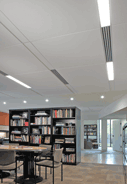
Armstrong
Monolithic ceiling adds new flavor to design consulting firm’s office space
The Atlanta design and architectural and consulting firm Greenway Group wanted to create a space with character when it moved into its new offices. The existing 2-by-2 acoustical panels with light fixtures and air diffusers were too basic for the image the company wanted to convey.
“When clients are in our office, we want them to leave with design ideas as well as strategic ideas,” says founding principal Jim Cramer.
The company decided to install a contemporary ceiling, choosing Armstrong’s new TechZone ceiling system to create a monolithic ceiling plane while delivering the required quantity and quality of light and air into the space.
The integrated ceiling system organizes light fixtures, air diffusers and sprinkler heads into a compact linear zone that visually coordinates with the company’s large-scale Optima fine-textured ceiling panels. The new system eliminates the need for penetrations in the acoustical ceiling panels.
“It imparts a very clean, custom look to the space, even though it uses standard components,” says Cramer. “Ceilings usually don’t elicit many comments from our staff or our clients, but this one is different. Even though it’s a suspended acoustical ceiling, it gives the impression of a drywall ceiling with linear light fixtures.”
|
|

Automated Logic
Pilot program cuts energy costs 25 percent in county buildings
Officials in Bexar County, home to San Antonio and 1.4 million residents, knew they had their work cut out for them when the Texas Senate passed a bill that required local governments to reduce energy consumption by 5 percent each year over five years.
One of the first steps Vince Fuentez took when he was hired as energy manager in 2004 was to create a formal energy management program. The program called for capital improvements, reduced utility consumption, a system to track energy use and an energy education program for employees.
To begin, Fuentez rolled out a pilot program on the fourth and fifth floors of the county administration building and the central plant for the courthouse and justice center. “One of the first things I looked at was controlling the equipment,” says Fuentez. “It was costing us a lot in operations and maintenance.”
To make the pilot program work, Fuentez selected Automated Logic’s WebCTRL program. The program allows facility executives to define occupancy schedules, adjust setpoints and control other parameters that affect interior temperatures.
An added feature allows the Web-based system’s optimal start-stop function to adjust HVAC operations to outside temperature and humidity levels, which can change quickly in the region.
Improved control in the test buildings led to a 25.4 percent reduction in energy costs, a savings of $109,510 between January 2004 and August 2005. “The project paid for itself in two months,” says Fuentez.
Based on the success, Fuentez is hoping to extend control capabilities countywide to security, lighting, backup power, environmental monitoring and other functions.
|
|
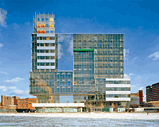
Constellation NewEnergy
Long-term renewable energy contract signals environmental commitment
From the inside out, Genzyme wanted its new headquarters in Cambridge, Mass., to be a world-class green building for its 900 employees.
That meant the company would pursue a LEED-platinum certification, the highest rating offered by the U.S. Green Building Council’s rating system for green buildings. Meeting this goal required designers take a holistic approach to building design, looking for every possible LEED credit, including renewable energy. Genzyme selected Constellation NewEnergy to supply the building with renewable energy.
Energy costs are estimated to be 42 percent lower than a conventional building.
All of the building’s electricity comes from renewable sources, either from a solar array on the roof or from Constellation NewEnergy. The latter is generated from wind, water, and biomass materials based on a three-year, fixed-price agreement for Green-e certified renewable electricity.
“We relied heavily on the use of glass throughout the building, and incorporated eighteen indoor gardens and rooftop solar panels as part of our design,” says Rick Mattila, director of environmental affairs for Genzyme.
LEED certification criteria require companies to purchase green power for at least two years to earn credit. Signing a three-year fixed price agreement saved the company $50,000 compared to a short-term non-renewable energy contract. The purchase of renewable power through a long-term contract also helped Genzyme hedge against electricity market volatility.
The building earned LEED-platinum certification in September 2005.
|
|

Firestone
Garden roofing system helps new transit center earn LEED certification points
Making the Rapid Central Station the first transit center to be certified by the U.S. Green Building Council’s LEED rating system for green buildings was an ambitious goal.
As a transit center, the Grand Rapids, Mich., project had its share of obstacles to LEED certification, including a significant amount of asphalt and concrete in parking lots. One strategy planners at the Interurban Transit Partnership used was a Firestone Garden Roofing System to help earn the building LEED certification.
The roof could contribute to improved air quality, reduce rooftop heat gain, and provide a habitat for birds and insects.
Less than two inches thick from root barrier through the planting substrate, the 15,600-square-foot roofing system retains 60 to 100 percent of the rainfall it receives. The system also mitigates the urban heat island effect and decreases air conditioning costs by acting as a barrier to energy transfer from the sun.
To install the garden roofing system, a tapered Firestone ISO 95+ polyisocyanurate insulation was attached to the steel deck, followed by an additional 1.5-inch layer of polyiso and a protection board. A 60-mil Firestone EPDM membrane was then adhered to the board. A protection fabric, drainage board and moisture retention mat were installed over the EPDM membrane in preparation for the Xero Flor planting substrate.
The garden roofing system used a hardy variety of sedum with a non-aggressive root system. The green roof was precultivated at ground level to provide coverage when installed and reduce installation time.
|
|

GAF
At historic library, 20-year guarantee is crucial to selection of roof restoration system
Built in 1891, the Omaha Historic Library Building’s roof was starting to show its age. The building’s roof deck is comprised of wood planking overlaid with standing seam copper, which has aged to an attractive patina green that gives the building its beauty and charm.
As with any 100-year-old building, portions of the roof were beginning to fail. Light rust was developing on steel skylight frames and exhaust vents. The roof was beginning to leak around some protrusions, skylights and crickets. Asphalt had been used to seal the leaks in the past, but that repair was starting to fail also.
GAF was chosen by property manager Investors Realty Inc. to install a new Topcoat titanium roof restoration system onto the historic building. The selection was based on the company’s 20-year, no-dollar-limit diamond pledge guarantee.
The guarantee stipulates that the roof be installed with a minimum of three coats of spray-applied Topcoat elastomeric roofing membrane, with at least 1.5 gallons of coating per 100 square feet. The final dry mil thickness of all coats must be 42 mils on the roof and all seams must have 90 mils of coating.
“The strict specifications required to restore the roof properly using the Topcoat products assures us we’re getting superior protection for many years to come,” says Debbie Wojcinski, property manager with Investors Realty, Inc., the management company for KEYFM LLC, which owns the building.
|
|

Georgia-Pacific
Hospital turns to glass-mat gypsum board to address mold concerns
When the Oakland, Calif., Children’s Hospital Research Center underwent a 28,000-square-foot expansion in 2003, preventing mold growth was a major priority.
“Mold resistance is an important part of our nosocomial infection control,” says James Jackson, vice president, ancillary and support services for the hospital. “We have some very sick kids, cancer patients, whose immune systems are low. We take mold very seriously.”
The project called for constructing a three-story tower in front of the 205-bed hospital, along with a variety of internal renovation projects. In the humidity-laden Bay Area, opening the hospital for construction meant exposing the building to increased moisture, which could have led to mold growth.
The hospital turned to Georgia-Pacific’s paperless DensArmor Plus glass-mat gypsum board. Instead of paper, the gypsum board uses glass mat, which eliminates the organic food source mold needs to survive.
While the project was under temporary protection from rain during construction, using DensArmor added an extra level of confidence that the building would remain protected.
“The building was under temporary protection when we began installing DensArmor Plus,” says Mark Pentico, construction manager. “That would have been a big risk with standard drywall. Even though we had no rain for two months during construction, we still have fog regularly with high moisture content.”
|
|

Knauf Insulation
Choice of ductwork helps keep construction, energy costs at bay in new marine biology facility
When Florida International University’s Biscayne Bay campus decided to build a new home
for the university’s marine biology program, a major goal was to keep the three-story building as comfortable and energy efficient as possible.
The site’s location near the edge of campus on Biscayne Bay made it ideal for the study of undersea life, but keeping construction and energy costs under control was a challenge. The university had initially considered stainless steel ductwork to combat corrosion, but found it wasn’t economical.
Instead, the university used Knauf Insulation’s KoolDuct system. The system uses a closed cell phenolic foam board faced on both sides with reinforced aluminum foil and patented aluminum flanges to connect duct sections and assure a strong, tight closure.
The ducting is a UL 181 Class 1-rated system and meets SMACNA Leakage Class 6 while providing thermal performance of R-6.7 at 7⁄8 of an inch thick. A thermal rating of R8.5 is available on ductwork 1-3⁄32 inches thick. During two rounds of air leakage tests, the ducting has yielded air loss readings of .4 percent and .6 percent.
The ducting installed faster and easier than traditional ductwork because of its weight — 85 percent less than sheet metal, which means the ducting doesn’t require the special lifts needed to install sheet metal.
|
|
The Metal Initiative
Metal facade helps corporate headquarters improve image
In deciding to expand its Ashland, Va., offices, Austrian-based Anton Paar USA wanted to ensure that its employees would not be kept in the dark.
Plans called for a section of the warehouse closest to the existing office area to be converted into a new applications lab, an enlarged service department, a shipping and receiving dock, a large break room and additional office space. A courtyard was also included. Construction of the courtyard helped the company resolve a serious lighting dilemma, namely how to expand its work area to an adjacent, underutilized warehouse that had only a few windows to the outside world.
In keeping with the high-tech image of the facility, the courtyard’s exterior was sided with 24-gauge, pre-formed vertical and horizontal steel panels with a silver coating. From new storefront windows along the perimeter of the laboratory and office spaces, employees can see natural plantings set against vertical lines of metal that rise to the very top of the two-story courtyard. Metal panels that flow horizontally cap the vertical panels.
The company had originally considered masonry, but felt it was too heavy. The silver finish of the metal better fit the building and resonated with the company’s history of technological innovation.
“For management and our employees, the courtyard offers the best of all worlds,” says Reinhard Eberl, president of Anton Paar USA. “It provides everyone with adequate daylight and a pleasant area in which to have lunch and entertain customers.”
|
|

Notifier
Fire alarm upgrade improves ability to detect false alarms, redundancy
Ranked as the 25th busiest airport in North America by the Airport Council International in 2003,
Lambert-St. Louis International Airport is a sizeable facility. The international airport’s 83 gates are home to 10 major airlines, 15 commuter airlines, five cargo airlines and two charter companies.
Even so, the rapidly expanding airport was outgrowing its space, leading to the largest capital improvement project in St. Louis history. One objective of the expansion was to ensure that the fire alarm system protected the expanded space while remaining compatible with the 5-year-old system already installed.
The airport chose Notifier, part of Honeywell’s life safety group, to handle the fire alarm upgrade. Backward compatibility meant the company’s systems would function with the two intelligent fire alarm control systems recently installed in the east terminal, along with older systems used in the airport.
With the upgrade, the entire airport is covered by the Noti-Fire-Net intelligent fire alarm network system. CAD drawings of the buildings were uploaded into the network control station so personnel can see the exact component that is producing an alarm. Graphical PC workstations make it possible to identify the source of a fire visually.
The network links multiple fire alarm control panels, which prevents the loss of one node from compromising other panels. Sensing algorithms embedded into the fire alarm control panels have the ability to separate false alarms from genuine emergencies.
|
|

Pella
New windows help historic school maintain architectural character
Growing program needs required an expanded McGinnis School in New Jersey’s densely populated Perth Amboy. Because the building was already situated on its property lines, an addition wasn’t feasible, nor was there a new site available for building.
To add space, planners enclosed an interior courtyard, added a mezzanine level and converted a balcony into library space. A basement was converted into a cafeteria by relocating mechanical systems into the attic.
The design team chose Pella windows to help maintain the architectural character of the 100-year-old school. Pella double-hung windows with fixed transoms were chosen to replace the existing aluminum windows, which had fallen into disrepair. The original curve-top windows in the school that had been filled-in during the 1950s were replaced with the company’s windows.
To ease installation, Pella provided the technical resources needed to plan, design and detail the window portion of the project — including turnkey fabrication and installation. The company designed a custom subframe installation based on its on-site measurement of the window openings.
Maintenance and safety concerns led to the selection of the company’s dual-glazing system with blinds between the glass. This system was chosen to provide light control to the classrooms, while protecting window treatments from dust and damage. The glazing system also incorporates muntins to create the appearance of historically accurate divided lites.
|
|

Russelectric
Improved switchgear allows financial firm to keep critical services running
To keep up with rapid growth, Putnam Investments opened several new facilities in the Boston area between 1994 and 2000. To make sure electricity in the facilities was always available, Putnam selected Russelectric to provide backup power to the facilities. With more than 10 million shareholders and 172 institutional clients, the company couldn’t afford to let its money-management services lapse because of a power failure.
Each facility has a 3,000 kw backup power system with three Caterpillar generators, Russelectric’s closed-transition paralleling switchgear and redundant programmable logic controllers (PLCs). The PLCs coordinate the systems and monitor utility feeds and can switch to emergency power during a power interruption.
Electricity reliability was improving at the company’s Franklin, Mass., facility, but still failed an average of 14 times annually between 1994 and 1999. The generators and switchgear installed allow the company to run on backup power for up to 10 days, if necessary.
An uninterruptible power supply (UPS) means that in the event of a power loss, computers never lose power. The closed-transition switchgear automatically starts the generators, picking up loads in order of priority. The UPS system covers the power in the 20 seconds it takes the generators to start, while the closed-transition design allows the system to be regularly tested without interrupting power for building occupants
|
|

Sarnafil
Retail company doesn’t play games with roofing replacement program
A boom in business for national toy retailer Toys “R” Us during the mid-1980s led to rapid growth — the company built nearly 50 new stores each year for a decade.
The roofs on many of those stores are nearing the end of their service lives, leading the company to seek a roof replacement that offers longevity and be applied without disrupting existing operations.
With the built-up roof on the company’s Newington, N.H., store experiencing substrate and membrane cracking, replacement was recommended before the end of 2005. Sarnafil was chosen to lead the replacement project.
“We’ve done a lot of research on the different roofing systems and we’ve visited several manufacturers,” says Alex DeBiasi, senior facilities manager for 125 Toys “R” Us stores in the Northeast. “Every roof we put on we expect big things from. Sarnafil is one of our selected, highly scrutinized membranes.”
Using the Sarnafil Services division meant the company also acted as project manager during the roof installation, working on site with the roofing contractor to ensure the job proceeded smoothly. The project was complete in a month, with the building remaining operational and watertight during the pro-cess, with minimal noise to distract customers.
By the end of 2005, seven Toys “R” Us replacement roofs were protected by Sarnafil roofing systems.
|
|
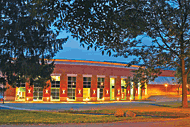
SimplexGrinnell
Networked fire and security system allows for expansion at college
Home to 2,100 students and 70 properties, Muhlenberg College in Allentown, Penn., needed an upgraded fire alarm system that would protect students and be robust enough to accommodate growth on the campus.
“Due to the expansion of the college over the years, the panels eventually ran out of points, which necessitated an upgrade in 2003,” says Tom Dougherty, assistant chief of campus safety at Muhlenberg.
SimplexGrinnell planned a networked solution to provide state-of-the-art fire alarm and security system technology to accommodate the college’s annual budget and phased timeline.
The company migrated the older access control system to a new EAS technology platform to support 2,000 dual-technology photo I.D. cards, using proximity technology for entry and magstripe technology for library card and cafeteria services.
With the project’s completion, the college’s eight academic buildings and nine major residence halls have a full Simplex fire alarm system and electronic card access control. The Simplex 4120 network fire alarm system installed provides system redundancy and the capability to support 50,000 addressable points along the system.
Each building has its own panel, and each panel is a node on the network. The entire fire alarm system is tied together through an information management system and an operator management computer workstation. The workstation provides operators with an alarm display, custom action messages for dispatchers, and report generation of detector sensitivity.
The new integrated fire and security system helped reduce false pull station alarms and theft.
|
|

Sloan
Prison addresses water use concerns, vandalism with program water technology
Facility executives at High Desert State Prison in Susanville, Calif., had a problem. Overcrowding and high water usage meant the prison and its 4,000 inmates were exceeding water use limits set by the local sewer and water treatment agency.
Equally troubling, inmates were flushing plastic bags, clothing and anything they could get their hands on in an attempt to clog the lines and cause trouble in the facility.
To help reduce vandalism and bring water usage under control, the corrections facility installed Sloan Valve’s program water technology (PWT) system, a computerized control device that enables administrators to turn water on and off to toilets, sinks and showers and program preset limits into the fixtures.
The installation of Sloan’s MicroPlumb low-consumption Royal Flushometer valve bodies in the prison’s high-security yard, along with the PWT system has reduced water consumption by about a third, says Dena Schweizer, utility shop supervisor.
Equally important, the number of maintenance calls for blocked lines has been reduced. The facility has programmed its system to allow inmates two flushes within five minutes. The system blocks flushing for an hour if inmates attempt to exceed the limit.
In addition to preset limits, the system can be adjusted in the field. A handheld wireless device can immediately activate or shut down fixtures in individual cells or in various building sections.
|
|
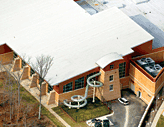
Stevens
Thermoplastic roof gives recreation center upscale look at reduced cost
The Cub Run RECenter in Chantilly, Va., was intended to be an environmentally responsible building that blended with its surroundings and was affordable to maintain.
The recreational center is home to a 4,800-square-foot recreational pool, two water slides, a 25-yard-by-25-meter competition pool, spa, fitness center, meeting rooms and office space.
The roofing system selected was a light slate gray Stevens EP Profile System, which offers the look of a standing seam metal roof with the waterproofing integrity of a thermoplastic single-ply membrane.
The original plan called for a standing-seam metal roof but financial considerations required a change to a single-ply roofing system with the profile to mimic the look of a metal roof.
The building’s odd-shaped roof made for a challenging installation. The Stevens EP Profile was installed on all the roof surfaces that are visible from the ground.
Workers had to fully adhere the Stevens EP membrane over the entire surface. First, 22-gauge steel decking was installed on the entire facility. A layer of half-inch DensDeck was then installed to provide a uniform and flat working surface. Because the recreational center has a pool, a vapor barrier was installed over the DensDeck on the large flat sloping portion of the roof.
Finally, 3 inches of Stevens ISO 2000 insulation was installed on the facility to provide an R-19 energy rating. The 60 mil light gray Stevens EP membrane was then fully adhered in place.
The roofing system included 10-foot-long extruded EP batten strips that emulate the look of a standing seam metal roof.
|
|

Steril-Aire
UVC disinfection system allows air recirculation, reduces natural gas use
Facilities executives in Pierce County, Wash., wanted to find a way to reduce natural gas heating costs at the existing Tacoma Jail and at an addition, while also making sure the indoor air was as healthy as it could be.
“With the jail occupied to full capacity on a 24/7 basis, we previously had to bring in 100 percent outside air which was very costly to heat,” says Jim Loewen, project manager for the department of facilities management at Pierce County.
Research in 2001 had shown that using ultraviolet-c (UVC) disinfection would allow the jail to have up to 30 percent of its air safely recirculated. Installing UVC lamps in the air handling systems was projected to save the jail 34,102 therms of natural gas each year at the existing building and 39,491 therms in the addition.
More than 100 of Steril Aire’s UVC lamps were installed opposite the cooling coils in the air handling units in the jail and addition. The high output UVC energy continuously kills bacteria, viruses and other harmful microbes, preventing them from spreading through the building. UVC also kills any mold and organic debris that may build up on the surfaces of the cooling coils, which helps maintain coils in “as new” condition.
The UVC light tubes are changed annually to maintain their effectiveness.
A review of the jail’s utility bill has shown a savings of more than $77,000 annually in reduced natural gas cost.
“Even after we subtract the parts and labor costs for servicing and changing the UVC lamps, annual savings still exceed $55,000,” says Loewen.
|
|
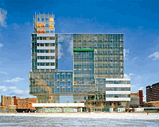
TAC
Integrating control of building systems saves costs, helps earn LEED points
Biotechnology company Genzyme Corp., wanted its new 12-story, 350,000-square-foot corporate headquarters to be a green building that not only lowered operational, maintenance and energy costs, but also provided a work environment with significant natural light and fresh air.
One challenge was finding a company that could integrate the building’s various systems, from renewable energy sources to lighting. Design specifications for the building included movable mirrors placed on the roof to direct sunlight inside, blinds programmed to follow the sun and then close at night, and operable windows.
Genzyme chose TAC to control building systems because the company could integrate systems from multiple manufacturers. TAC’s Andover Continuum products control the main building while Andover Report Suite measures and reports energy trends. These measurements are required for obtaining the U.S. Green Building Council’s Leadership in Energy and Environmental Design (LEED) rating. The building achieved platinum certification, the highest LEED rating available.
The Andover Continuum system is fully programmable and uses a Microsoft Windows NT front-end workstation connected directly to Genzyme’s Ethernet VPN. The configuration enables Genzyme to monitor and manage operations such as HVAC equipment, chiller and boiler interfaces, carbon monoxide and carbon dioxide levels, rainwater collection, artificial lighting, opening and closing windows and blinds, door controls, and building and tenant metering.
“The controllers interface with lighting components to yield significant savings by eliminating the need for a separate network system to handle the lighting,” says Lou Capozzi, facilities engineering, Genzyme Corporation. The system also allows individual lighting and HVAC control, he says.
|
|

UNICCO
Cleaning program helps employees reduce waste, improve recycling
When Bank of America invested $60 million to renovate a former jewelry manufacturing building into a call center for 900 employees in East Providence, R.I., it wanted to develop the building in an environmentally responsible fashion.
Located in a part of the city in need of economic development, the long-vacant building was retrofitted with advanced energy management, telephony, lighting and electrical services, ergonomic work stations and other amenities, including dining facilities, fitness and wellness rooms, and ATMs.
The company’s commitment to the environment didn’t end with the construction process. The operation is virtually paperless to the point where most employees do not need waste baskets. Any office paper that is produced is shredded and recycled. Other materials, such as plastics and glass, are also collected and recycled through centralized collection bins.
To make recycling easy for employees, UNICCO Service Co., the Bank’s cleaning contractor, introduced its UNICCO GreenClean program. The program incorporates environmental awareness by explaining in its associate orientation program how associates can participate in the effort. “We want folks to understand that we have a real serious commitment to green and to partnering with our UNICCO teammates to stay consistent with the GreenClean program,” says Mary-Jude Dean, senior vice president and call center executive.
|
|

Watt Stopper/Legrand
Occupancy sensors help warehouse slash energy costs
With energy costs rising, Menlo Worldwide Logistics, a global supply chain management company, wanted to reduce energy consumption at its 120,000-square-foot distribution center in Fremont, Calif.
But the company also wanted to make sure that any change to its lighting system improved the working environment for its employees. Prior to the retrofit, the facility was lit 24 hours a day, regardless of occupancy, with 400-watt metal-halide high-bay fixtures.
The company selected a lighting system that consisted of Watt Stopper/Legrand’s high-bay fixture occupancy sensors, wall switch replacement sensors, and high-efficiency six-lamp T8 fixtures.
The occupancy sensors use passive infrared technology to sense the difference between an occupant and the background space, allowing the lighting to be automatically activated when an employee is present. After the space becomes vacant for a user-determined time interval, the light is turned off.
Adding occupancy sensors allowed significant portions of the facility to go unlit when unused. Under the old system, large portions of the facility were being lit during work shifts despite being unoccupied. Even the restrooms received occupancy sensors during the upgrade.
Energy consumption information during the first six months indicates that the upgrade has led to an energy savings of 44 percent compared to the prior year, exceeding initial projections. The company also received a $28,000 grant from the local utility for the project.
|
|


























